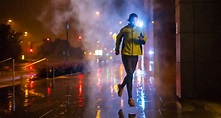Running In The Dark
1 - Avoid loud music
Listening to music is a great way to stay motivated, but keeping your headphones plugged in top volume can be distracting, keeping you from staying alert to what's happening around you.
When lighting conditions are poor, it's difficult to see obstacles, vehicles and other runners! Reducing your hearing means you're less likely to be aware of oncoming cars, people and animals.
Use a low volume setting on your running headphones to ensure you're still aware of what's going on around you.
2 - Stay visible
Wearing light coloured and hi-viz clothing is essential for running in the dark. It's important for drivers and other people to be able to see you, so invest in running gear with reflective detailing or get yourself some hi-viz accessories.
Always ensure you're visible from the front and the back so both directions of traffic will see you.
3 - Lights
If running in the early morning or late at night is commonplace for you, consider investing in a running head torch and light to ensure not only you can see the path ahead, but others can see you too.
4 - Run with a friend or a group
The age old adage is true; there is safety in numbers. As the days get shorter. run with a friend or join a running group.
5 - Tell someone where you're going
It's always a good idea to tell someone where you’re going. Whether it’s a quick text to a friend or telling someone at home, ask them to contact you if they don’t hear from you after your expected time home.
6 - Take your phone
If you don’t fancy telling someone every time you pop out for a run, carry your phone with you just in case. It’s so easy now to carry your phone with lightweight, and sweat-wicking phone holders - and it means you can use your favourite run-tracking apps like Strava on the go.
7 - Run against traffic
When running in poor light, always run against the traffic so you can see any potential dangers coming. You’re much more likely to be able to get out the way quickly of cars or road users if you can see them first.
Be aware of headlights too; if you see flashes of light coming round a corner or a busy road, avoid crossing until the vehicle has passed.
8 - Well-lit route
It’s important for you to be able to see your surroundings too. Stick to well-lit routes to reduce your risk of tripping or stumbling. If you're trail or fell running where there is no light, be sure to wear a head torch or running lights.
9 - Vary your routes and times
Try not to run the same route at the same time every day. Being predictable makes you more of a target and you’re less likely to pick up on small changes or potential danger.
10 - Instincts
Trust your instincts. They’re probably right. If you don’t feel comfortable, move to a better lit area or head home.
